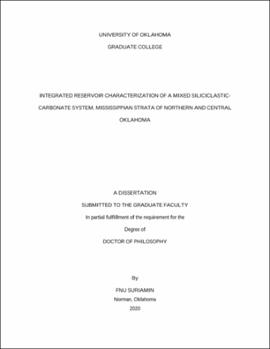| dc.description.abstract | The Mississippian strata have been a long sought-after reservoir objective in Oklahoma. These reservoirs have produced several million barrels of oil since early in the 20th century. Despite hundreds of thousands of wells have been drilled into these reservoirs throughout the state of Oklahoma, their stratigraphy and fundamental controls on reservoir quality and occurrence have remain elusive and enigmatic. Studies, documented in this dissertation, have resulted in the generation of lithofacies variations, depositional environment, and sequence-stratigraphic models that are applicable to the exploration of these reservoirs.
Study of Mississippian strata in the Mississippian Limestone play area reveals the presence of 17 lithofacies and 29 high-frequency cycles. The lithofacies are predominantly skeletal-rich limestones. The good reservoir quality is typically associated with the upper intervals of these high-frequency shallowing-upward cycles. Pore characterization using digital-image analysis of 58 thin-sections photomicrographs exhibits unique correlations among core porosity, permeability, and lithofacies within a sequence-stratigraphic framework. These correlations are: 1). porosity from digital-image analysis (DIA) and laboratory core measurements has a strong positive relationship (R2 = 0.94). However, some values from DIA porosity yield relatively higher values, specifically in fine-grained lithofacies. The difference is due to the present of isolated nanopores that are not accessible by helium during measurement of core porosity. 2). The relationship between pore circularity and permeability is indeterminate. The indeterminate relationship is related to a complex internal pore network, intensive diagenetic alteration, an unconnected microfracture network, and isolated pores. 3). Coarse-grained lithofacies within the uppermost depositional sequence of the Mississippian interval have a heterogeneous pore-size distribution while fine-grained lithofacies tend to exhibit a homogenous pore-size distribution.
In the STACK Play area, eastern Anadarko Basin of central Oklahoma, the Mississippian strata consists of 8 lithofacies and are dominated by detrital-rich lithofacies. Study on 5 cores (260 m; 850 ft) suggests these lithofacies were deposited in wave-dominated nearshore with a restricted embayment (lagoon) and channels or lobes. Analysis of 34 thin sections indicates the lithofacies have undergone diagenetic alteration including calcite cementation, mechanical compaction, albitization, quartz cementation, silicification, dolomitization, Fe-dolomite cementation, pyritization, and dissolution. A paragenesis scheme suggests that quartz cementation occurred earlier compared to albitization and Fe-dolomite cementation. The Fe-dolomite is the latest authigenic mineral formed whereas the quartz and calcite cement can be attributed to earlier diagenesis. The reservoir quality is significantly reduced by compaction, calcite and quartz cements, as well as amount of clay minerals. However, the dissolution of cement and detrital grains tends to improve reservoir quality by forming secondary pores.
The 8 lithofacies in the STACK play area can be grouped into 3 rock types based on their dominant minerals composition. Rock type 1 is characterized by relatively moderate clay (22% - 39%), quartz (26% - 43%), and carbonate (25% - 47%) contents and lower effective porosity (<2%). Rock type 2 has relatively higher quartz (43% - 48%), moderate carbonate (20% - 45%) and clay (6% - 18%) contents and higher effective porosity (4% - 7%). Rock type 3 has relatively higher percentage of carbonates (61% - 85%), lower clay (<11%) and quartz (8% - 30%) contents and moderate effective porosity (2% - 4%). In terms of reservoir quality, rock type 2 is the best reservoir rocks with high storage capacity and brittleness.
Stratigraphically, The Mississippian strata of the STACK play area consist of 1 low stratigraphic order with overall upward-deepening profile. The intermediate stratigraphic order correlates to multiple depositional episodes consisting of lowstand-, transgressive-, and highstand systems tract. Clay-rich rock type 1 typically increases during late highstand systems tract and lowstand system tract and quartz-rich rock type 2 typically increases during transgressive systems tract and early highstand systems tract. The higher stratigraphic order exhibits an ideal upward-shallowing succession within parasequences that consists of bioturbated siltstone, laminated-siltstone, structureless siltstone, and cross-laminated siltstone. Proximally, individual cycles are often capped by skeletal wackestone-packstone. A sequence boundary is characterized by a subaerial exposure with brecciated chert or an erosional surface; and glauconitic siltstone-sandstone is typically present atop of this boundary.
The threefold (low, intermediate, and high) stratigraphic orders combined with a dip-oriented 3D model indicate that the reservoir sweet spots containing higher percentage of quartz-rich rock type 2 occur during deepening in the transgressive and highstand systems tract (parasequence Miss 9 to Miss 12). These stratigraphic orders provide a predictive framework that aids in reservoir characterization for optimal development of the Mississippian reservoirs. | en_US |
